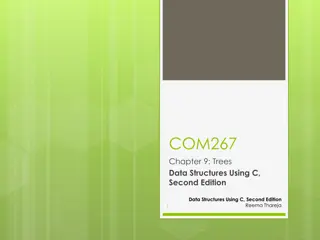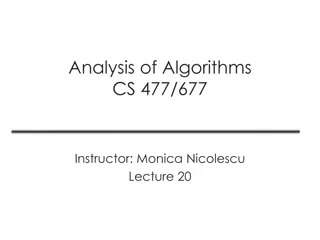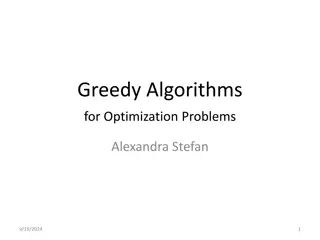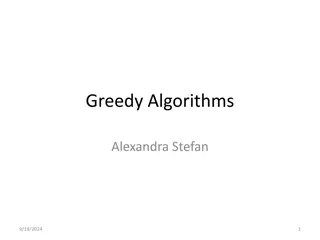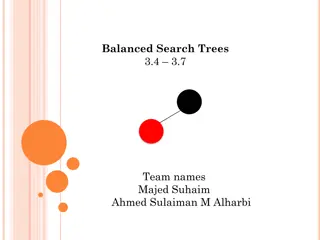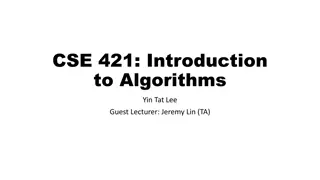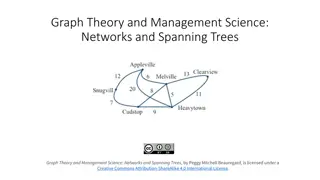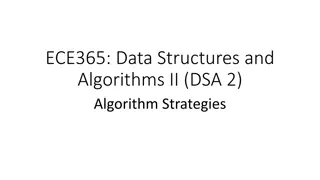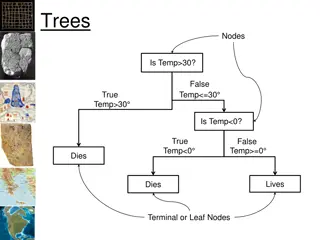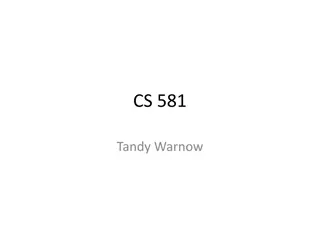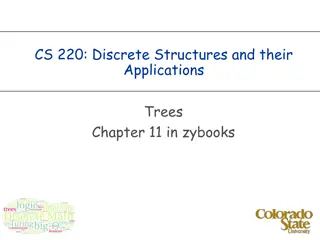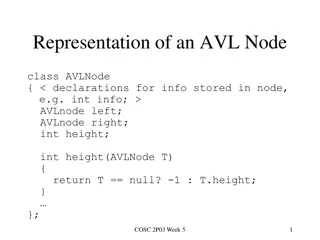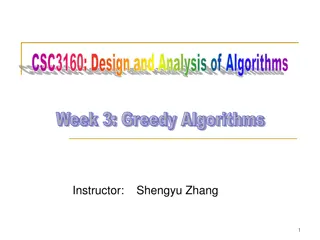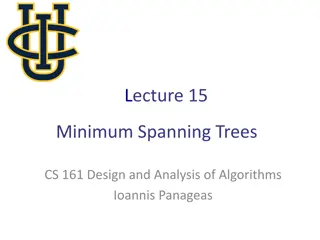Spanning Trees, greedy algorithms
In CS2110 Fall 2018, explore the concepts of spanning trees and greedy algorithms through lecture slides. Learn about amortized time complexity, undirected trees, facts about trees, and spanning tree definitions. Discover examples and methods for finding a spanning tree in a connected undirected graph.
Uploaded on Feb 20, 2025 | 0 Views
Download Presentation

Please find below an Image/Link to download the presentation.
The content on the website is provided AS IS for your information and personal use only. It may not be sold, licensed, or shared on other websites without obtaining consent from the author.If you encounter any issues during the download, it is possible that the publisher has removed the file from their server.
You are allowed to download the files provided on this website for personal or commercial use, subject to the condition that they are used lawfully. All files are the property of their respective owners.
The content on the website is provided AS IS for your information and personal use only. It may not be sold, licensed, or shared on other websites without obtaining consent from the author.
E N D
Presentation Transcript
1 HEY, SIGN UP FOR LUNCH. LOTS OF OPENINGS Spanning Trees, greedy algorithms Lecture 20 CS2110 Fall 2018 1
About A6, Prelim 2 Prelim 2: Thursday, 15 November. Visit exams page of course website and read carefully to find out when you take it (5:30 or 7:30) and what to do if you have a conflict. Time assignments are different from Prelim 1! Time assignments are different from Prelim 1! Time assignments are different from Prelim 1! Time assignments are different from Prelim 1! HEY, SIGN UP FOR LUNCH. LOTS OF OPENINGS
Amortized time Visit JavaHyperText, put amort into Filter Field, read the first ---one-page--- pdf file. In A5 Heap.java, insert takes amortized time O(1). WHAT DOES THAT MEAN? Look at a scenario, to give you an idea c filled to capacity, say 20 1 add double array, add 20 1 add, 1 copy 1 add double array, add 40 1 add, 2 copy 1 add, 1 copy 1 add
Undirected trees An undirected graph is a tree if there is exactly one simple path between any pair of vertices What s the root? It doesn t matter! Any vertex can be root.
Facts about trees 5 Tree with #V = 1, #E = 0 #E = #V 1 connected no cycles Tree with #V = 3, #E = 2 Any two of these properties imply the third and thus imply that the graph is a tree
Facts about trees 6 #E = #V 1 connected no cycles Any two of these properties imply the third and thus imply that the graph is a tree
Spanning trees A spanning treeof a connected undirected graph (V, E) is a subgraph (V, E') that is a tree Same set of vertices V E' E (V, E') is a tree 7 Same set of vertices V Maximal set of edges that contains no cycle Same set of vertices V Minimal set of edges that connect all vertices Three equivalent definitions
Spanning trees: examples http://mathworld.wolfram.com/SpanningTree.html 8
Finding a spanning tree: Subtractive method Start with the whole graph it is connected While there is a cycle: Pick an edge of a cycle and throw it out the graph is still connected (why?) Maximal set of edges that contains no cycle nondeterministic algorithm One step of the algorithm
Aside: Test whether an undirected graph has a cycle /** Visit all nodes reachable along unvisited paths from u. * Pre: u is unvisited. */ public static void dfs(int u) { Stack s= (u); // inv: All nodes to be visited are reachable along an // unvisited path from a node in s. while (s is not empty) { u= s.pop(); if (u has not been visited) { visit u; for each edge (u, v) leaving u: s.push(v); } } } We modify iterative dfs to calculate whether the graph has a cycle
Aside: Test whether an undirected graph has a cycle /** Return true if the nodes reachable from u have a cycle. */ public static boolean hasCycle(int u) { Stack s= (u); // inv: All nodes to be visited are reachable along an // unvisited path from a node in s. while (s is not empty) { u= s.pop(); if (u has been visited) returntrue; visit u; for each edge (u, v) leaving u { s.push(v); } } returnfalse; }
Finding a spanning tree: Subtractive method Start with the whole graph it is connected While there is a cycle: Pick an edge of a cycle and throw it out the graph is still connected (why?) Maximal set of edges that contains no cycle nondeterministic algorithm One step of the algorithm
Finding a spanning tree: Additive method Start with no edges Minimal set of edges that connect all vertices While the graph is not connected: Choose an edge that connects 2 connected components and add it the graph still has no cycle (why?) nondeterministic algorithm Tree edges will be red. Dashed lines show original edges. Left tree consists of 5 connected components, each a node
Minimum spanning trees 14 Suppose edges are weighted (> 0) We want a spanning tree of minimum cost (sum of edge weights) Some graphs have exactly one minimum spanning tree. Others have several trees with the same minimum cost, each of which is a minimum spanning tree Useful in network routing & other applications. For example, to stream a video
Greedy algorithm A greedy algorithm follows the heuristic of making a locally optimal choice at each stage, with the hope of finding a global optimum. Example. Make change using the fewest number of coins. Make change for n cents, n < 100 (i.e. < $1) Greedy: At each step, choose the largest possible coin If n >= 50 choose a half dollar and reduce n by 50; If n >= 25 choose a quarter and reduce n by 25; As long as n >= 10, choose a dime and reduce n by 10; If n >= 5, choose a nickel and reduce n by 5; Choose n pennies. 15
Greediness works here 16 You re standing at point x. Your goal is to climb the highest mountain. Two possible steps: down the hill or up the hill. The greedy step is to walk up hill. That is a local optimum choice, not a global one. Greediness works in this case. x
Greediness doesnt work here 17 You re standing at point x, and your goal is to climb the highest mountain. Two possible steps: down the hill or up the hill. The greedy step is to walk up hill. But that is a local optimum choice, not a global one. Greediness fails in this case. x
Greedy algorithm doesnt always work! A greedy algorithm follows the heuristic of making a locally optimal choice at each stage, with the hope of finding a global optimum. Doesn t always work Example. Make change using the fewest number of coins. Coins have these values: 7, 5, 1 Greedy: At each step, choose the largest possible coin Consider making change for 10. The greedy choice would choose: 7, 1, 1, 1. But 5, 5 is only 2 coins. 18
Finding a minimal spanning tree Suppose edges have > 0 weights Minimal spanning tree: sum of weights is a minimum We show two greedy algorithms for finding a minimal spanning tree. They are abstract, at a high level. They are versions of the basic additive method we have already seen: at each step add an edge that does not create a cycle. Kruskal: add an edge with minimum weight. Can have a forest of trees. Prim (JPD): add an edge with minimum weight but so that the added edges (and the nodes at their ends) form one tree
MST using Kruskals algorithm Minimal set of edges that connect all vertices At each step, add an edge (that does not form a cycle) with minimum weight edge with weight 2 5 3 5 3 edge with weight 3 4 4 4 4 6 6 2 2 One of the 4 s The 5 5 5 3 3 5 3 4 4 4 4 4 4 6 6 6 2 2 2 Red edges need not form tree (until end)
Kruskal Minimal set of edges that connect all vertices Start with the all the nodes and no edges, so there is a forest of trees, each of which is a single node (a leaf). At each step, add an edge (that does not form a cycle) with minimum weight We do not look more closely at how best to implement Kruskal s algorithm which data structures can be used to get a really efficient algorithm. Leave that for later courses, or you can look them up online yourself. We now investigate Prim s algorithm
MST using Prims algorithm (should be called JPD algorithm ) Developed in 1930 by Czech mathematician Vojt ch Jarn k. Pr ce Moravsk P rodov deck Spole nosti, 6, 1930, pp. 57 63. (in Czech) Developed in 1957 by computer scientist Robert C. Prim. Bell System Technical Journal, 36 (1957), pp. 1389 1401 Developed about 1956 by Edsger Dijkstra and published in in 1959. Numerische Mathematik 1, 269 271 (1959)
Prims algorithm Minimal set of edges that connect all vertices At each step, add an edge (that does not form a cycle) with minimum weight, but keep added edge connected to the start (red) node edge with weight 3 5 3 5 3 edge with weight 5 4 4 4 4 6 6 2 2 One of the 4 s The 2 5 3 5 5 3 3 4 4 4 4 4 4 6 6 6 2 2 2
Minimal set of edges that connect all vertices Difference between Prim and Kruskal Prim requires that the constructed red tree always be connected. Kruskal doesn t But: Both algorithms find a minimal spanning tree Here, Prim chooses (0, 2) Kruskal chooses (3, 4) Here, Prim chooses (0, 1) Kruskal chooses (3, 4) 0 3 0 5 2 5 1 2 1 2 4 4 6 4 6 4 3 3 4 4 2 3
Minimal set of edges that connect all vertices Difference between Prim and Kruskal Prim requires that the constructed red tree always be connected. Kruskal doesn t But: Both algorithms find a minimal spanning tree Here, Prim chooses (0, 2) Kruskal chooses (3, 4) Here, Prim chooses (0, 1) Kruskal chooses (3, 4) 0 3 0 5 2 5 1 2 1 2 4 4 6 4 6 4 3 3 4 4 2 3
Minimal set of edges that connect all vertices Difference between Prim and Kruskal Prim requires that the constructed red tree always be connected. Kruskal doesn t But: Both algorithms find a minimal spanning tree If the edge weights are all different, the Prim and Kruskal algorithms construct the same tree.
Implement JPD to create a maze The graph is a grid. Each node is connected by an edge to its neighbors. There is no need to implement edges. Each node has an edge to its North, East, West, and South neighbors: N, E, W, S If being drawn in a GUI, draw a black line between adjacent nodes. 27
Implement JPD to create a maze The graph is a grid. Each node is connected by an edge to its neighbors. There is no need to implement edges. Automatically, each node has an edge to its North, East, West, and South neighbors: N, E, W, S b Choose beginning node b randomly, make it white 28
Implement JPD to create a maze The graph is a grid. Each node is connected by an edge to its neighbors. All nodes that have been added to the spanning tree are white. They have in them a letter b, N, E, W, or S ---as will be seen later. b 29
Implement JPD to create a maze The graph is a grid. Each node is connected by an edge to its neighbors. All nodes that have been added to the spanning tree are white. They have in them the letter b, N, E, W, or S ---as will be seen later. b The frontier set are nodes that are adjacent to white nodes. They are in an ArrayList F. We make them blue. 30
Implement JPD to create a maze Here s ONE step of the algorithm. 1. Choose a random Frontier (blue) node, 2. Make it white (put in spanning tree), remove it from Frontier. 3. Put in it a letter to indicate edge to the white node to which it was adjacent. 4. Remove black line between the the two nodes. 5. Add adjacent nodes to the Frontier b N 31 (Remember, don t add a cycle)
Implement JPD to create a maze Here s ONE step of the algorithm. 1. Choose a random Frontier (blue) node, 2. Make it white (put in spanning tree), remove it from Frontier. 3. Put in it a letter to indicate edge to the white node to which it was adjacent. 4. Remove black line between the the two nodes. 5. Add adjacent nodes to the Frontier b N N 32
Implement JPD to create a maze Here s ONE step of the algorithm. 1. Choose a random Frontier (blue) node, 2. Make it white (put in spanning tree), remove it from Frontier. 3. Put in it a letter to indicate edge to the white node to which it was adjacent. 4. Remove black line between the the two nodes 5. Add adjacent nodes to the Frontier b N W N 33
Implement JPD to create a maze Important pts about implementation No implementation of edges. They are in our head Nodes with a letter in them are in the spanning tree. N indicates an edge of spanning tree to node to North (similar for E, W, S) b N E N Frontier set (blue nodes) is an ArrayList. Efficient to choose one at random and to remove it from set 34
Maze generation using Prims algorithm The generation of a maze using Prim's algorithm on a randomly weighted grid graph that is 30x20 in size. https://en.wikipedia.org/wiki/Maze_generation_algorithm jonathanzong.com/blog/2012/11/06/maze-generation-with-prims-algorithm 35
Greedy algorithms 36 Suppose the weights are all 1. Then Dijkstra s shortest-path algorithm does a breath-first search! 1 1 1 1 1 1 1 1 Dijkstra s and Prim s algorithms look similar. The steps taken are similar, but at each step Dijkstra s chooses an edge whose end node has a minimum path length from start node Prim s chooses an edge with minimum length
Breadth-first search, Shortest-path, Prim 37 Greedy algorithm: An algorithm that uses the heuristic of making the locally optimal choice at each stage with the hope of finding the global optimum. Dijkstra s shortest-path algorithm makes a locally optimal choice: choosing the node in the Frontier with minimum L value and moving it to the Settled set. And, it is proven that it is not just a hope but a fact that it leads to the global optimum. Similarly, Prim s and Kruskal s locally optimum choices of adding a minimum-weight edge have been proven to yield the global optimum: a minimum spanning tree. BUT: Greediness does not always work!
Similar code structures 38 Breadth-first-search (bfs) best: next in queue update: D[w] = D[v]+1 Dijkstra s algorithm best: next in priority queue update: D[w] = min(D[w], D[v]+c(v,w)) Prim s algorithm best: next in priority queue update: D[w] = min(D[w], c(v,w)) while (a vertex is unmarked) { v= best unmarked vertex mark v; for (each w adj to v) update D[w]; } c(v,w) is the v w edge weight
Graph Algorithms Search Depth-first search Breadth-first search Shortest paths Dijkstra's algorithm Minimum spanning trees Prim's algorithm Kruskal's algorithm










